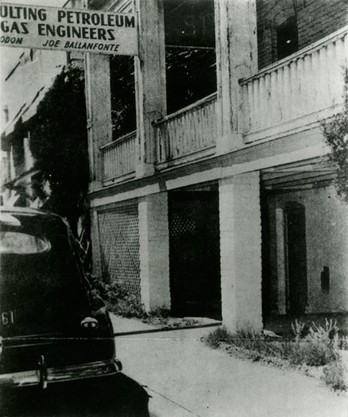"The Basement School" (1947) and Sweatt v. Painter (1950)
Introduction
Text-to-speech Audio
Images
The University of Texas rented the bottom floor of this building to house the School of Law of the Texas State University for Negroes. Used with the permission of the Briscoe Center for American History.

Backstory and Context
Text-to-speech Audio
The founding of the School of Law of the Texas State University for Negroes was a result of Texas’ attempts to preserve segregation in response to the legal challenge presented by the court case Sweatt v. Painter. In early 1946, Heman Marion Sweatt, a Houston mail carrier and former teacher who held a bachelor’s degree from Wiley College, applied to the University of Texas (UT) School of Law. Though qualified for admittance, the school rejected Sweatt’s application due to the state’s segregated education laws. Since there were no law programs for African Americans in Texas, UT President Theophilus Painter informed Sweatt that he should apply for an out-of-state scholarship, provided by the government in order to meet the “separate but equal” clause of the Plessy v. Ferguson ruling (1896) that justified segregation.
Sweatt responded by filing a suit against UT and Painter in May 1946. Backed by the National Association for the Advancement of Colored People (NAACP), the case forced the courts to weigh in on Black educational opportunities, which declared that Sweatt’s constitutional rights had been violated due to the lack of a Black law school within state boundaries. The court gave the government six months to rectify the situation. While seeking to bolster the status of Prairie View University (now Prairie View A&M) – the state’s lone Black public university – the legislature also passed Senate Bill 140 in March 1947. The law established the Texas State University for Negroes in Houston (now Texas Southern University), with plans for a school of law to be established immediately in Austin.
Even before the bill passed, UT administrators and professors had begun making plans for the new law school. It would draw on faculty from the flagship campus and almost immediately began receiving donations for a small library. According to author Gary M. Lavergne, the university leased four rooms on the bottom floor of a multi-tenant building located on 13th Street at the edge of the Texas State Capitol grounds. Derided by NAACP lawyers as a basement, the rooms were more accurately on the ground floor below the raised entrance of the structure, though it was necessary to descend a few steps to access the main door located under the gallery porch above. The legislature never meant for this structure to be the permanent home of the school, but rather a temporary residence hastily assembled to derail the Sweatt case as the permanent university took shape in Houston.
Unfortunately for champions of segregation, the school’s first semester was an abject failure. Sweatt refused his offer of admittance to the school, while the NAACP worked hard to dissuade enrollment of other students. Not a single student signed up for any of the three classes during the first registration period held in mid-March 1947, just days after SB 140 became law. Local Black activists discouraged potential students, and only three enrolled the next fall, with one dropping out almost immediately. In late September, a Daily Texan article noted that Henry Doyle – an Austin grocer – was the only student enrolled and therefore “the center of attention of five teachers” that constituted the school’s part-time faculty. Doyle was also the only student to move with the program to Houston when it and its meager collection of books became a component of the Texas State University for Negroes.
"I am pleased to advise that your qualifications heretofore established and your application heretofore made will entitle you to attend the new school now being opened at 104 East 13th Street, Austin, Texas." Letter from E. J. Mathews to Heman Sweatt, March 3, 1947.
While the supposed goal of the school was – according to a Daily Texan article published March 2, 1947 – to “give instruction equivalent to the same instruction being offered at the University of Texas School of Law,” the reality clearly did not approach the standard. Though segregated education in Texas had never been “separate but equal,” comparison of the established UT School of Law with the improvised basement institution illustrated just how superficial this standard had become. Even though the school’s instructors came from UT, there was no comparison in terms of the courses offered, access to expertise, library resources, student experience, or professional connections through alumni – of which there were none. NAACP lawyers argued that beyond the physical deficiencies of makeshift solutions such as the “Basement School,” intangible factors also made segregated education inherently unequal. This argument won the day when presented to the Supreme Court in 1950, which struck down the lower courts’ decisions and declared Sweatt’s denial of admission unconstitutional. This victory against segregated higher education would inform later challenges to the “separate but equal” doctrine, most notably the celebrated case of Brown v. Board of Education of Topeka in 1954.
Cite This Entry
M., Ben, R Joseph Parrott, and Clio Admin. ""The Basement School" (1947) and Sweatt v. Painter (1950)." Clio: Your Guide to History. June 17, 2019. Accessed April 4, 2025. https://theclio.com/tour/17/3
Sources
Jonathan L. Entin, "Sweatt v. Painter, the End of Segregation, and the Transformation of Education Law," The Review of Litigation, 5:3 (1986): 3-71 Andrea Hsu. "'Sweatt V. Painter': Nearly Forgotten, But Landmark Texas Integration Case." NPR. 10 October 2012. http://www.npr.org/sections/thetwo-way/2012/10/10/162650487/sweatt-vs-texas-nearly-forgotten-but-lan...
"Heman Sweatt and Sweatt v. Painter," Jamail Center for Legal Research, Tarleton Law Library. http://tarlton.law.utexas.edu/heman-sweatt
Jo White, “Law Student Doyle Becomes Top Man in the Class of ’50,” Daily Texan, 25 September 1947. “Negro School Opens March 10 if Bill Passed,” Daily Texan, 2 March 1947.

